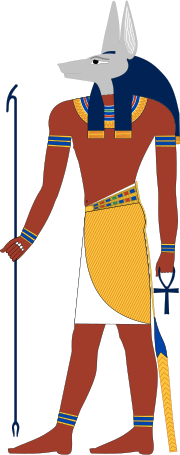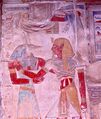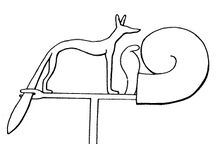وپواوت
| وپواوت Wepwawet | |||||
|---|---|---|---|---|---|
 وپواوت، فاتح الطرق. وپواوت كثيراً ما يُصوَّر كذئب أبيض أو رمادي أو ابن آوى، ويجب ألا يُخلط بينه وبين أنوبيس. | |||||
| الاسم بالهيروغليفية |
| ||||
| مركز العبادة الرئيسي | ليكوپوليس، أبيدوس | ||||
| الحيوانات | الذئاب | ||||
| الرمز | الذئب، ابن آوى، الصولجان، القوس، سهام الصيد | ||||
| معلومات شخصية | |||||
| الأبوان | ست، نفتيس | ||||
| الأشقاء | أنوبيس | ||||
وپواوت أو ويبواويت Wepwawet أو أوبواوت Upuaut هو أحد الآلهة المصرية القديمة ، هو فاتح الطريق معبود (آسيوط). was originally a deity of funerary rites, war, and royalty association, whose cult centre was Asyut في مصر العليا (Lycopolis in the Greco-Roman period). His name means opener of the ways and he is often depicted as a wolf standing at the prow of a solar-boat. Some interpret that Wepwawet was seen as a scout, going out to clear routes for the army to proceed forward.[1] One inscription from the Sinai states that Wepwawet "opens the way" to king Sekhemkhet's victory.[2]
Wepwawet originally was seen as wolf deity, with his cult center being at the Lycopolis, (meaning city of wolves in Greek). He is one of the earliest Egyptian Gods on record. Wepwawet was heavily seen in association with royalty and the Pharaoh (My face is that of Upwawet, Pyramid Texts), symbolizing and protecting their rise to power, accompanying them on hunts (in which capacity he was titled [one with] sharp arrows more powerful than the gods alone) or in the pharaoh's ascent to the Duat, or afterlife.[3]

|
جزء من سلسلة مقالات عن |

|
|
المعتقدات الرئيسية
وثنية • وحدة الوجود • تعدد الآلهة |
| الشعائر |
| صيغة التقديم • الجنائز • المعابد |
| الآلهة |
| أمون • أمونت • أنوبيس • أنوكت أپپ • أپيس • آتن • أتوم باستت • بات • بس أبناء حورس الأربعة گب • هاپي • حتحور • حقت حورس • إيزيس • خپري • خنوم خونسو • كوك • معحص • ماعت معفدت • منحيت • مرت سگر مسخنت • مونتو • مين • مر-ور موت • نون • نيت • نخبت نفتيس • نوت • اوزيريس • پاخت پتاح • رع • رع-حوراختي • رشپ ساتيس • سخمت • سكر • سركت سوبك • سوپدو • ست • سشات • شو تاورت • تفنوت • تحوت واجت • واج-ور • وپواوت • وسرت |
| النـصـوص |
| عمدوعت • كتاب التنفس كتاب المغارات • كتاب الموتى كتاب الأرض • كتاب الأبواب كتاب العالم السفلي |
| غيرهم |
| الآتونية • لعنة الفراعنة |
Over time, the connection to war and thus to death led to Wepwawet also being seen as one who opened the ways to, and through, Duat, for the spirits of the dead. Through this, and the similarity of the jackal to the wolf, Wepwawet became associated with Anubis, a deity that was worshiped in Asyut, eventually being considered his brother. He was seen as both having the head of a wolf and sometimes a jackal, like Anubis. He also was said to be Set's son. Consequently, Wepwawet is often confused with Anubis.[2] This deity appears in the Temple of Seti I at Abydos.[2]
In later Egyptian art, Wepwawet was depicted as a wolf or a jackal, or as a man with the head of a wolf or a jackal. Even when considered a jackal, Wepwawet usually was shown with grey, or white fur, reflecting his lupine origins. In rare cases, he appeared in fully human form. however there is some academic debate as to whether the Grey pigmentation is authentic with some scolars disputing this and stating that he was most often depicted with black fur, like Anubis. The discrepancy in color is most often attributed to pigment degradation, or the pigment variety chosen by the artist (for Wepwawet, Anubis, and other Jackal Gods such as Duamutef[4]).
He was sometimes depicted dressed as a soldier, as well as carrying other military equipment—a mace and a bow.
For what generally is considered to be lauding purposes of the pharaohs, a later myth briefly was circulated claiming that Wepwawet was born at the sanctuary of Wadjet, the sacred site for the oldest goddess of Lower Egypt that is located in the heart of Lower Egypt. Consequently, Wepwawet, who had hitherto been the standard of Upper Egypt alone, formed an integral part of royal rituals, symbolizing توحيد مصر.
في نصوص الأهرام اللاحقة، Wepwawet is called "Ra" who has gone up from the horizon, perhaps as the "opener" of the sky.[2] In the later Egyptian funerary context, Wepwawet assists at the Opening of the mouth ceremony and guides the deceased into the netherworld.[2]
أصل التسمية
يدل معنى اسمه هذا على طبيعته في الكشف والتجوال ، وربما كان ذلك الاسم مجرد نعت حيث أن اسمه الحقيقي والذي ورد منذ عصر مبكر تماما كان (سد Sed) والذي كان رمزه الذي يعلو ساريته يشبه تماما في مظهره رمز (أوبواوت) أو لواؤه يحمل أمام الملك في ساحة القتال أو مواكب النصر ، ويدل الإسم اليوناني (ليكوپوليس Lykopolis) (لأسيوط) ومعناه مدينة الذئب، أن الإغريق قدروا أن الحيوان المقدس للمعبود (أوبواوت) هو الذئب قالب:كتاب الديانة المصرية
في الثقافة الشعبية
في Crusader Kings III، الإله وپواوت هو كبير الآلهة في ديانة كردفان.[5]
Wepwawet is the personal god or totem of Thu, the main character in the Lady of the Reeds books by Canadian author Pauline Gedge (House of Dreams, 1994; and House of Illusions, 1996).
الأصل الحيواني
While we do not know for certain the exact species of animal represented by the Ancient Egyptian sꜢb / sAb animal (Jackal/wolf), the African wolf (Canis lupaster) was one species thought to depict and the template of numerous Ancient Egyptian deities, including Wepwawet.[6] Other species theorized include the black-backed jackal also called the silver-backed Jackal (C. mesomelas or Lupulella mesomelas) and golden jackal or Asiatic jackal (Canis aureus).
The Egyptian jackal was listed as a subspecies of the golden jackal but molecular and osteological data has established that it is a unique species in its own right. It is native to Egypt, Libya, and Ethiopia, though its post-Pleistocene range once encompassed the فلسطين.
Inter-breeding between species also cannot be ruled out, and it has been posited that a species sharing the characteristics of both African jackal and wolf species could be the missing link, such as the combination of C. aureas and C. lupus lupaster appearing as Canis aureus lupaster.[7]
معرض صور
وپواوت تعطي صولجانات لـ ستي الأول، نقش بارز من معبد ستي الأول
تصوير لـ وپواوت، 664–332 ق.م.، متحف بروكلن
اسكتش لنصب يصور الفرعون وپواوت إم ساف يقف أمام وپواوت، ح. القرن 17 ق.م.
رمسيس الثالث أمام وپواوت في نقش من مدينة هابو، ح.
تمثال وپواوت مع الإلهة إيزيس-حتحور، يعود لمسئول اسمه Siese الذي عمل في عهد رمسيس الثاني
تمثال لـوپواوت، المتحف البريطاني
العبادة
أسيوط كانت مركز لعبادة الإله ويبواويت .
انظر أيضاً
المصادر
- ^ Pat Remler, Egyptian Mythology A to Z: A Young Readers Companion, Facts on File Inc., 2000. p. 170 Note: Remler's reference only states that Wepwawet's name means 'Opener of the ways'.
- ^ أ ب ت ث ج Remler, p.170
- ^ DuQuesne, Terence (1991). Jackal at the Shaman's Gate. Darengo Publications. p. 12. ISBN 1-871266-14-9.
You will ascend towards towards the sky as Horus, Upon the celestial sledge of the Opener of the Ways" [Pyramid Texts §§796-799 (Sethe)]
- ^ Wilfong, Terry G. "Death Dogs: The Jackal Gods of Ancient Egypt".
- ^ "Religion - CK3 Wiki".
- ^ Remler, P. (2010). Egyptian Mythology, A to Z. Infobase Publishing. p. 99. ISBN 978-1438131801.
- ^ Pouls Wegner, Mary-Ann. "Wepwawet in Context: A Reconsideration of the Jackal Deity and Its Role in the Spatial Organization of the North Abydos Landscape". Journal of the American Research Center in Egypt.









